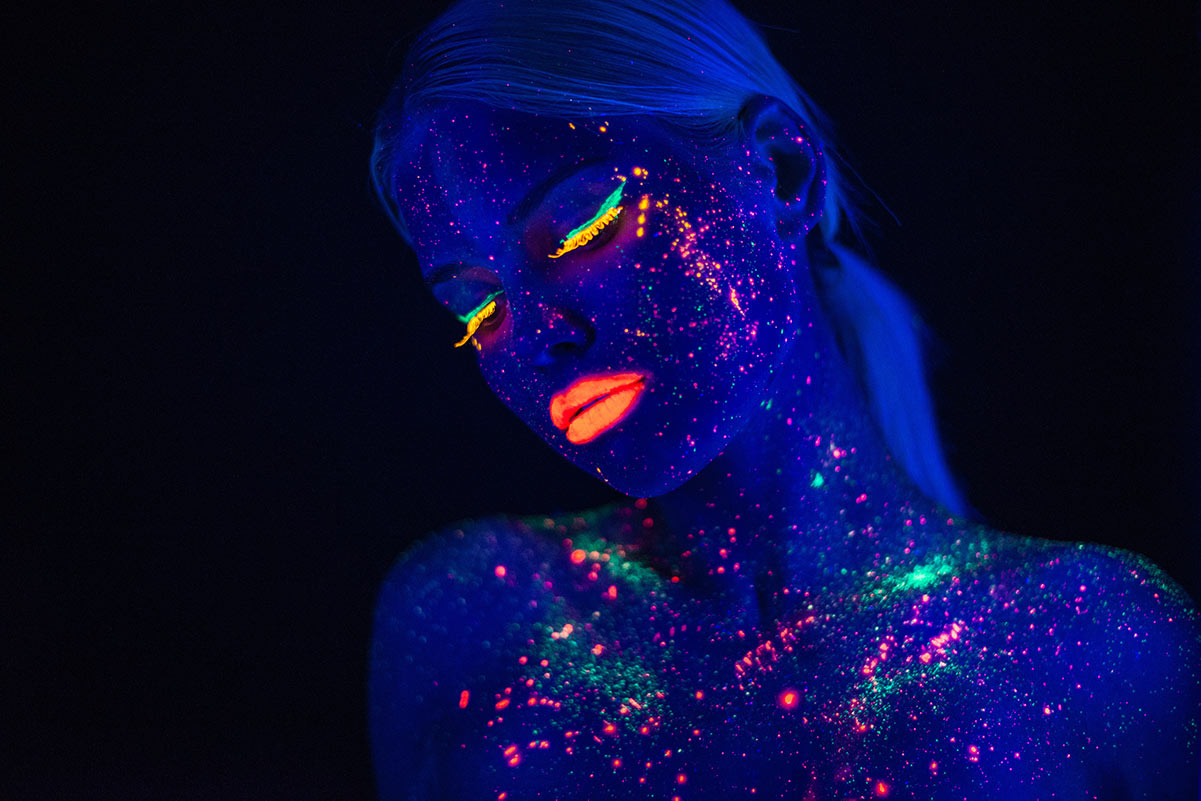Whether you are a kid or an adult, it’s hard to not be impressed at the amazing effects created by glow in the dark paint. But just how does glow in the dark paint work? In this article we’ll take a look at science behind these clever materials, and how they produce such an amazing phenomenon.
First – A Brief Introduction To Light
You probably know sound travels in waves, but you might not know that light also travels in waves. And just like sound, there is a broad range of lengths of light waves. As it turns out, only a small part of those wavelengths is visible to humans – a part which you’ve probably heard of called “the visible spectrum”.
Within the visible spectrum you have different colors, which are caused by different wavelengths of light. Red is short wavelength, while blue lives at the long wavelength end of the visible spectrum. Outside the visible spectrum is infra-red light (which you cannot see) and ultraviolet (UV) – which you also cannot see.
Different Types of Glow In The Dark Paint
As you’ve probably noticed from our review of glow in the dark paints, there are two main types of glow in the dark paint. The first type, blacklight paint, is technically called fluorescent paint. The second type, called glow in the dark paint, is called phosphorescent paint. Let’s take a look at each in more detail.
How Blacklight Paint Works
Blacklight paint – or fluorescent paint – exhibits some interesting characteristics which make it unlike any other material. Most materials reflect or absorb whatever light or sound waves hit them without altering the waves. The only exception to this is the prism or the rainbow.
Fluorescent paint absorbs invisible UV light, but then emits it again as visible light at a shorter wavelength. So, the paint is not itself emitting light, rather reflecting light back at you in a visible wavelength.
You have probably seen blacklights in crime television shows. These lights emit UV “black” light, which is invisible to the naked eye. But when it falls onto a fluorescent paint, it reflects brightly in the visible spectrum. This is why fluorescent paints work well in concerts and dark rooms. No other light is visible, unless it is reflected from the UV blacklight.
How Phosphorescent Paint Works
Glow in the dark paint – of phosphorescent paint – works in a similar but slightly different manner. Rather than reflecting light back at your immediately, phosphorescent paint continues to reflect light back for a long time. This is why glow in the dark materials need to be charged up.
When you charge up a phosphorescent paint, you expose it to UV and other light forms. When you then put the UV painted material into a dark room, it continues to reflect and emit the visible light for a long time. Regular fluorescent paint would appear dark, but phosphorescent paint appears visible as it emits reflected light.
The History Of Phosphorescence
Discovery
Phosphorescence was first discovered in 1604, by the Italian chemist Vincenzo Cascariolo. He discovered a stone which, after heating in an oxygen furnace, appeared to absorb and re-emit light.
At the time, this discovery perplexed many scientists who could not offer any explanation. The so called “philosophers stone” was thought to be linked to the art of alchemy. It was commonly believed that placing it near materials would turn them into gold.
Today, we know the material he discovered was a mineral called Baryte. The process which he discovered is called calcination, and is used widely in the chemical industry today. While not all calcinated Baryte glows, certain forms of the mineral do exhibit these properties.
Modern Manufacturing
These days, glow in the dark paints are made using either zinc sulphide or strontium aluminate. These two chemicals exhibit the same properties as the philosopher’s stone, but are much easier to produce in large quantities.
Phosphorescent materials are used extensively in children’s toys, concerts and art. Combined with other materials, a variety of interesting effects can be created which continue to wow people to this day.






